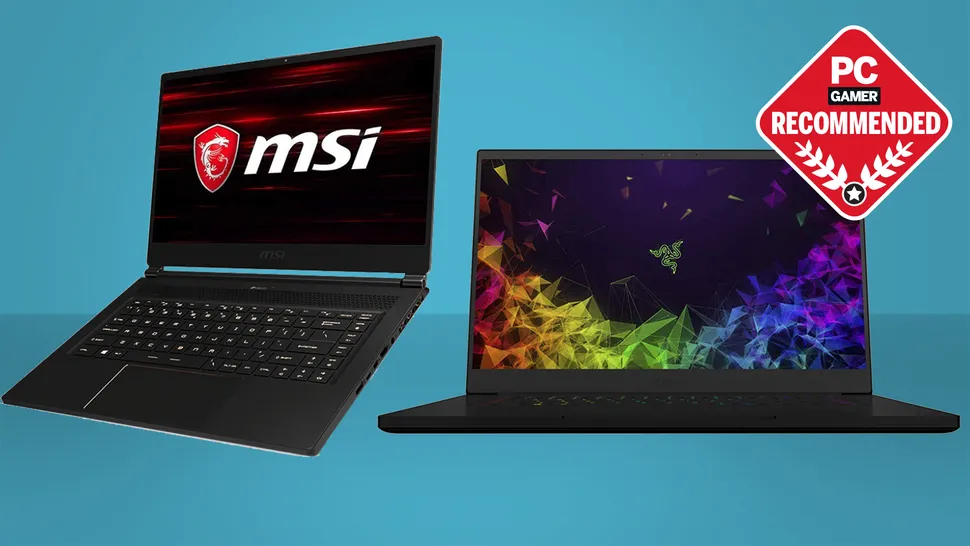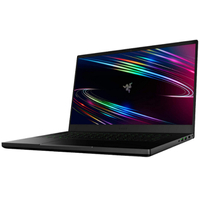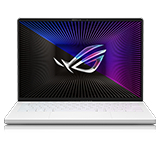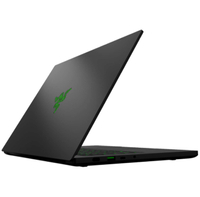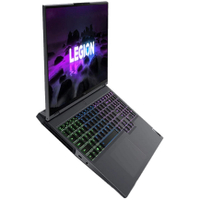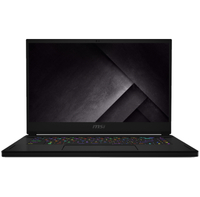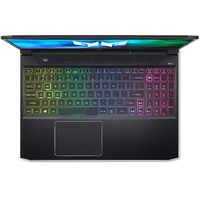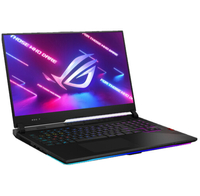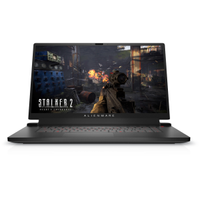Best gaming laptops in 2022
The best gaming laptop is all about performance, portability, and price. Whether it's a sleek ultrathin gaming notebook or a full-on desktop replacement, gaming laptops offer a versatility for their owners you simply can not get from a desktop gaming PC.
As the battle between AMD and Intel rages, anyone shopping for a new gaming laptop will have many great options. On the CPU front, AMD's Ryzen 6000-series processors have been giving Intel's 12th Gen Alder Lake chips a run for its money. The same can be said about AMD's new mobile GPUs slowly closing the gap to Nvidia's RTX 30-series offerings.
The newest gaming laptops are getting more portable yet still sport all the fancy features of high-end gaming PCs. We're talking multicore CPUs, high-end GPUs, and speedy NVMe SSDs. You can even find heaps of RAM and super-high refresh screens under the hood. Gaming laptops with mechanical keyboards even exist, in case you can't live without that sweet clackity clack like the Asus ROG Strix Scar 15.
Thankfully, gaming laptops mostly sidestepped chip shortages and are generally available for purchase. However, it looks does mean manufacturers have focused on providing more high-end configs though they are some exceptions like Dell, who offer some pretty impressive sub-$1000 gaming laptops.
Of the hundreds of gaming laptops we've tested over the years, the ones that make this list always offer the best of three things; best balance of performance, portability, and price. Whether you're a student, professional, or just a gamer, there should be a laptop that's right for you here, and we'll continue to update this guide with the latest models as they're pushed out.
Best gaming laptops
Our favorite config:
The latest spin of the Razer Blade 15 once again improves on one of the best gaming laptops ever made. It has the same gorgeous CNC-milled aluminum chassis as its predecessor, only this time it can house one of Nvidia's latest RTX 30-series GPUs and an Intel 12th Gen Core i9 CPU.
We've played with the Razer Blade 15 Advanced with a 10th Gen Intel chip and RTX 3080 (95W) GPU inside it. And we fell in love all over again. We've also since then tried out the larger Razer Blade 17 with an RTX 3080 Ti humming away inside it, alongside one of those tasty 12th Gen chips and still stand bewildered by what will fit inside such a compact and neat chassis.
The Razer Blade 15 is the overall best gaming laptop on the market right now.
That said, you will get some throttling because of that slimline design, and even on the larger Blade 17 the battery life can be a little slim, but you're still getting outstanding performance from a beautiful machine.
The Blade 15 isn't the lightest gaming laptop you can buy, but five pounds is still way better than plenty of traditional gaming laptops, while also offering similar performance and specs. That heft helps make it feel solid too. It also means the Blade 15 travels well in your backpack. An excellent choice for the gamer on the go... or if you don't have the real estate for a full-blown gaming desktop and monitor.
Keyboard snobs will be happy to see a larger shift and half-height arrow keys. The Blade 15 Advanced offers per-key RGB lighting over the Base Model's zonal lighting. Typing feels great, and I've always liked the feel of the Blade's keycaps. The trackpad can be frustrating at times, but you're going to want to use a mouse with this gorgeous machine anyway, so it's not the end of the world.
One of the best things about the Blade 15 is the number of configurations Razer offers. From the RTX 3060 Base Edition to the RTX 3080 Ti Advanced with a 144Hz 4K panel, there's something for almost everyone. It's one of the most beautiful gaming laptops around and still one of the most powerful.
Whatever config you pick, we think the Razer Blade 15 is the overall best gaming laptop on the market right now, though you will be paying a premium for the now-classic design.
Read our full Razer Blade 15 Advanced Edition (2020) review.
Our favorite config:
The new version of the Zephyrus G14 for 2022 impresses us once again with its well-balanced spec and excellent gaming performance. Seriously, this thing shreds through frames up to its 120Hz refresh rate, and it's great for much more than gaming, too.
We checked out the version with AMD's RX 6800S under the hood, though there is an option for an RX 6700S, for a chunk less cash. Arguably, that cheaper option sounds a bit better to us, as the high-end one can get a little pricey and close in on the expensive but excellent Razer Blade 14. It's not helped much by its 32GB of DDR5-4800 RAM in that regard, though we do love having all that speedy memory raring to go for whatever you can throw at it.
At its heart is the AMD Ryzen 6900HS. That's one of the top chips from AMD's Ryzen 6000-series, but not its best and brightest—though you're really fighting over boost clocks and not much else when it comes to the tippy top of the red team's mobile processors anyways. It delivers eight cores and 16 threads of the Zen 3+ architecture, capable of boosting to 4.9GHz (which it actually does on occasion), so that's more than acceptable by me.
I'm heartily impressed with the G14's gaming performance overall.
That GPU and CPU combo makes quick work of our benchmarking suite, however, and I have to say I'm heartily impressed with the G14's gaming performance overall. That's even without turning to the more aggressive Turbo preset—I tested everything with the standard Performance mode. It's able to top the framerate of RTX 3080 and RTX 3070 mobile chips pretty much across the board, and while it does slip below the RTX 3080 Ti in the Razer Blade 17, that's a much larger laptop with a much larger price tag.
One of my favorite things about the G14 is in the name—it's a 14-inch laptop. The blend of screen real estate and compact size is a great in-between of bulkier 15- and 17-inch designs, and not quite as compromised as a 13-inch model can feel. But the big thing with the 2022 model is that the 14-inch size has been fitted out with a larger 16:10 aspect ratio than previous models' 16:9 panels.
When it's running smoothly, the G14's high refresh and high-resolution panel also looks fantastic. Being such a bright and colorful IPS display on this model, you really get to soak in every detail.
One of the downsides with this machine is the battery life, which really isn't the best while gaming—less than an hour while actually playing. You'll get more when playing videos or doing something boring like working, but we do expect a bit more from a modern laptop. It's not a deal-breaker, but definitely something you'll want to bear in mind.
The G14 has lost that quality of being surprisingly cheap for what you get, too, even if you do get stellar performance out of it.
Perhaps one reason for that is the inclusion of 32GB of DDR5 RAM—16GB of that is soldered to the board, and the other 16GB attached via removable SO-DIMM from the underside of the laptop. That's not cheap memory. DDR5 prices have hardly settled down since the memory standard was introduced last year, and 32GB is a bounty of high-performance memory by comparison to most gaming PCs today.
Overall, though, the G14 experience is a pretty easy and straightforward one. I didn't run into any major issues with it over the couple of weeks I've had it, and for the few negatives I have with the design, Asus has offset them with heaps of positives. The cheaper models may be a better bet than the one we reviewed, however. The same chassis and great design but with a slightly more amicable price tag.
Read our full Asus ROG Zephyrus G14 2022 (GA402RK) review.
Our favorite config:
I am mighty tempted to push the Razer Blade 14 further up the list, simply because the 14-inch form factor has absolutely won me over. The Asus ROG Zephyrus G14 in the No. 2 slot reintroduced the criminally under-used laptop design, but Razer has perfected it. Feeling noticeably smaller than the 15-inch Blade and closer to the ultrabook Stealth 13, the Blade 14 mixes a matte black MacBook Pro-style with genuine PC gaming pedigree.
The Razer style is classic, and it feels great to hold, too. And with the outstanding AMD Ryzen 9 5900HX finally finding its way into a Blade notebook, you're getting genuine processing power you can sling into a messenger bag. And you're now able to get your hands on the Blade 14 with the brand new Ryzen 9 6900HX chip at its heart, though in practice that has changed very little apart from offering some decent integrated graphics.
But add in some extra Nvidia RTX 30-series graphics power—now all the way up to an RTX 3080 Ti, but wear earplugs—and you've got a great mix of form and function that makes it the most desirable laptop I've maybe ever tested.
My only issue is that the RTX 3080 Ti would be too limited by the diminutive 14-inch chassis and run a little loud. So I would then recommend the lower-spec GPU options, though if you're spending $1,800 on a notebook, that feels like too high for 1080p gaming. But you're not buying the Blade 14 specifically for outright performance and anything else; this is about having all the power you need in a form factor that works for practical mobility.
The PC is all about choice, and Razer has finally given us the choice to use an AMD CPU in its machines.
The PC is all about choice, and Razer has finally given us the choice to use an AMD CPU in its machines, although it would be great if we had the option elsewhere in its range of laptops. It's notable that we've heard nothing about a potential Blade 14 using an AMD discrete Radeon GPU alongside that Ryzen CPU. Ah well.
Forgetting the politics a second, the Razer Blade 14 itself is excellent, and is one of the most desirable gaming laptops I've had in my hands this year. Maybe ever. The criminally underused 14-inch form factor also deserves to become one of the biggest sellers in Razer's extensive lineup of laptops. And if this notebook becomes the success it ought to be, then the company may end up having to make some difficult choices about what CPUs it offers, and where.
The choice you have to make, though, is which graphics card to go with. Sure, the RTX 3080 Ti is quicker, but it leaves a lot more gaming performance on the workshop floor. That's why the cheaper RTX 3060, with its full-blooded frame rates, gets my vote every day.
Read our full Razer Blade 14 review.
Best Razer laptop for gaming | Best Acer laptop for gaming | Best MSI laptop for gaming| Best gaming keyboard | Best gaming mouse | Best gaming chair
Our favorite config:
The Legion Pro 5 proves that AMD is absolutely a serious competitor in the gaming laptop space. Pairing the mobile Ryzen 7 5800H with the RTX 3070 results in a laptop that not only handles modern games with ease, but that can turn its hand at more serious escapades too.
The QHD 16:10 165Hz screen is a genuine highlight here and one that makes gaming and just using Windows a joy. It's an IPS panel with a peak brightness of 500nits too, so you're not going to be left wanting whether you're gaming or watching movies.
The Legion Pro 5 really is a beast when it comes to gaming too, with that high-powered RTX 3070 (with a peak delivery of 140W it's faster than some 3080s) being a great match for that vibrant screen. You're going to be able to run the vast majority of games at the native 2560 x 1600 resolution at the max settings and not miss a beat. The fact that you can draw on DLSS and enjoy some ray tracing extras for the money all helps to make this an incredibly attractive package.
This is a lovely laptop to actually type on too. Folks have always gushed about how good Lenovo keyboards are; I always ignored them because I don't trust people that are too into keyboards. But, I will admit, I think I get it. The rounded bottom keycaps have a nice feel to them. Add that with the large 4.7 x 3-inch touchpad, and you've got yourself a lovely work laptop that plays games well. I wish other laptop makers would take advantage of the added space of 17-inch gaming laptops and use it to make our lives easier.
The Lenovo Legion Pro 5 made me realize that Legion laptops deserve a spot at the top.
If anything knocks the Legion 5 Pro, it would have to be its rather underwhelming speakers and microphone combo. Anything with a hint of bass tends to suffer, which is a shame. The microphone was another surprising disappointment. My voice, I was told, sounded distant and quiet during work calls, which paired with a mediocre 720p webcam doesn't make for the best experience. I will commend the Legion for fitting a webcam on a screen with such a small top bezel though—A for effort.
The Lenovo Legion Pro 5 made me realize that Legion laptops deserve a spot at the top, being one of the more impressive AMD-powered laptops we've gotten our hands on recently. From the bright, colorful screen to the great feeling full-sized keyboard, The Legion Pro 5 has everything you want in a gaming laptop for a lot less than the competition manages.
Read our full Lenovo Legion 5 Pro review.
Our favorite config:
The MSI GS66 is one hell of a machine: It's sleek, slick, and powerful. But it's not Nvidia Ampere's power without compromise, however. MSI has had to be a little parsimonious about its power demands to pack something as performant as an RTX 3080 into an 18mm thin chassis.
The top GPU is the 95W version, which means it only just outperforms a fully unleashed RTX 3070, the sort you'll find in the Gigabyte Aorus 15G XC. But it is still an astonishingly powerful slice of mobile graphics silicon.
It can get a little loud, but thankfully, you have the benefits of all the Nvidia Max-Q 3.0 features at your disposal. This includes Whisper Mode 2.0, which will bring gaming down to barely audible levels, for when you want to be stealthy.
The GS66 also comes with an outstanding 240Hz 1440p panel, which perfectly matches the powerful GPU when it comes to games. Sure, you'll have to make some compromises compared to an RTX 3080 you might find in a hulking workstation, but the MSI GS66 Stealth is a genuinely slimline gaming laptop.
It's seriously thin.
It's a shame laptop manufacturers are seemingly just content to use old chassis and cooling designs for their new Nvidia-based gaming laptops. Things are getting ever more thermally constrained when it comes to performance because new hardware is being dropped into old designs. This is the compromise with the GS66, and you have to be absolutely invested in having a low-profile gaming laptop to make it worth paying the price. And remember, that price is paid both in frame rates and in dollar bills.
Nvidia's new suite of Max Q goodies help, although it's a shame they are likely to be overlooked as manufacturers fail to offer consistent messaging about them and users aren't necessarily going to go digging into exactly how they all work. But they do work, and this latest tranche of gaming laptops will absolutely be the best we've ever seen. Unfortunately, it might just be tougher than ever to figure out exactly which machine is right for you.
There's a lot to love about the latest MSI GS66. This implicitly means there is also a lot that will frustrate. The overall machine is rather lovely—it's seriously thin, especially for a gaming laptop, and comes with some seriously tasty internal specs too, but there are places where it feels like it might have benefitted from a little extra design time.
Read our full MSI GS66 Stealth review.
Our favorite config:
We loved Acer's Predator Helios 300 during the GTX 10-series era, and the current generation Helios still manages to punch above its weight class compared to other $1,500 laptops. It may not be the best gaming laptop, but it's one of the best value machines around.
The newest version of the Helios packs an RTX 3060 GPU and a sleeker form factor without raising the price significantly. It also has a 144Hz screen and smaller bezels, putting it more in line with sleek thin-and-lights than its more bulky brethren of the previous generation.
The only real drawback is the diminutive SSD, although the laptop has slots for two SSDs and an HDD, which makes upgrading your storage as easy as getting a screwdriver. You often need to get handy with the upgrades at this end of the price spectrum, and the Helios 300 is no different in that respect.
If you're desperate for just that little bit of extra gaming performance and hang the sense of it—or the sound and fury of it—the Turbo button is Acer's one-touch GPU overclocking feature. The Predator laptops have this simple feature designed to eke out as much extra gaming performance as possible.
In theory, it's a neat feature but much as we saw with the Predator Triton earlier this year, you really only get about a 1-3% increase in performance. It also makes your system run very hot and distractingly loud. Honestly, I really don't think it's worth it unless you're truly militant about maximizing your frames per second. Or have a really good noise-canceling gaming headset.
But for its $1,500 sticker price, the 15-inch Predator Helios 300 provides high-end 1080p gaming performance at a mid-range price. Even without the dubious utility of the Turbo button. The design changes are small but smart—like the power cord in the back instead of the side, having room for three storage drives, and the price/performance ratio is great. And that all makes the Acer Predator Helios 300 a strong contender for one of the best gaming laptops around.
Read our full Acer Predator Helios 300 review.
Our favorite config:
There's absolutely no question you can buy a much more sensible gaming laptop than this, but there is something about the excesses of the ROG Strix Scar 17 that make it incredibly appealing. It feels like everything about it has been turned up to 11, from the overclocked CPU—which is as beastly as it gets—to the gorgeously speedy 360Hz screen on the top model. Asus has pushed that little bit harder than most to top our gaming laptop benchmarks.
And top the benchmarks of the best gaming laptops it does, thanks in the main to the GeForce RTX 3070 Ti that can be found beating away at its heart. This is the 150W version of Nvidia's new Ampere GPU, which means it's capable of hitting the kind of figures thinner machines can only dream of. You can draw on Nvidia's excellent DLSS, where implemented, to help hit ridiculous frame rates, too. And if that's not enough, you can also grab this machine kitted out with an RTX 3080 Ti too.
The 17-inch chassis means the components have a bit more room to breathe compared to the competition too, and coupled with the excellent cooling system, you're looking at a cool and quiet slice of gaming perfection. This extra space has allowed Asus to squeeze an optomechanical keyboard onto the Scar 17, which is a delight for gaming and more serious pursuits.
Importantly, all this power comes at a cost not only to the temperatures but also to the battery life. Sure, you're not as likely to play games with the thing unplugged, but if you ever have to, an hour is all you get.
I'm not enamored with the touchpad either, while we're nit-picking. I keep trying to click the space beneath it, and my poor, callous fingers keep forgetting where the edges are. This particular model doesn't come with a camera either, which is a glaring omission for the price, and there's a distinct lack of USB Type-A ports for the unnecessary arsenal of peripherals I'm packing. There are a couple of USB Type-C ports around the back to make up for it, though, and I'm happy there's a full-sized keyboard.
For a machine with a 17-inch chassis, it doesn't weigh the world and doesn't need two power adapters to work to its full potential either.
Such gripes are easy to overlook when Asus has managed to pack such an immense config in here. The frankly unnecessary 32GB of DDR5-4800 RAM and that 2TB SSD are awesome, but a bit over the top for most mortals.
For a machine with a 17-inch chassis, it doesn't weigh the world and doesn't need two power adapters to work to its full potential either. For that, it doesn't feel as much like a hulking desktop replacement as we've seen. And that's okay. Particularly when you crown a portable machine like this off with a 1440p, 240Hz IPS panel with 3ms response time, which also does a smashing job of reducing glare.
While you could get a Lenovo Legion 5 Pro with its RTX 3070 for half the price, spending $2,999 on this Strix Scar config will put you ahead of the competition with very little effort. And sure, it's not as stylish or as apt with ray tracing as the Blade 17, but there's a good $1,000 price difference there. And for something that can outpace the laptops of yesteryear in almost every running, I'd pay that price for sure.
Read our full Asus ROG Strix Scar 17 G733 review.
Our favorite config:
One thing I love about Alienware is the company's unrelenting confidence in its new products. Whether that's boasting about a desktop being a "Benchmark Bruiser" or releasing one of the slickest OLED gaming monitors to date. So, when I get offered the chance to check out the new Alienware m17 R5 it has dubbed "the most powerful 17-inch AMD Advantage gaming laptop," how can I pass that up?
Powering the Alienware m17 R5 is an AMD Ryzen 9 6900HX and Radeon RX 6850M XT combo that, on paper, seems like a slam dunk for Team Red. It's also the first gaming laptop we've tested with an RX 6850M XT, and so I was stoked to see how it stacked up against laptops with an RTX 3070 Ti and even RTX 3080 Ti mobile GPUs.
The surprisingly bright 500cd/m² 4K display got a lot of use for streaming video. I appreciate seeing the detailed stress lines on Guenther Steiner's face in the last season of F1: Drive to Survive in 4K on Netflix. Games look pretty good, though this display is better served for professionals and creatives. So if you don't fall into that category, you may be better off sticking with the 1080p display at 240Hz to save money and add time to your much-needed battery life.
This laptop also takes advantage of AMD's suite of game-boosting technologies, such as SmartAccess Graphics, which automatically switches your output from the Ryzen APU and Radeon GPU, along with Smartshift Max, which automatically shifts around your power depending on what app or game you're using. The good thing about these features is that they just work without you messing with them. All nice features, especially if you are bouncing between gaming and, let's say, video editing and trying to eke out extra horsepower.
On the GPU side, the Alienware m17 R5 AMD Advantage model excelled at nearly all our gaming benchmarks at 1080p on mostly maxed-out settings.
On the GPU side, the Alienware m17 R5 AMD Advantage model excelled at nearly all our gaming benchmarks at 1080p on mostly maxed-out settings. It hit triple-digit framerates in nearly all the games I played, with a Hitman 3 average of just over 200 fps.
If you value frame rate over resolution, the m17 R5 easily delivers over 100 fps frames on most games at 1080p. Even Cyberpunk was hitting around 128 fps (with FSR turned on). The high 120Hz refresh rate on the display means you'll run into little to no screen tearing. Because of the drastically higher frame rates, I played more games at 1080p than 4K. If you're playing a shooter like Apex Legends or Fortnite, that's the way to go, which makes the 4K display a bit redundant much of the time.
The Alienware m17 R5 might not be the most powerful gaming laptop ever, but it isn't through lack of trying. Even with the CPU performance lagging behind some of its rivals, the m17 R5 makes up the deficit with impressive gaming results. The 4K display is great for anyone watching movies or working, but you could save a few hundred dollars by scaling down some of the more expensive components and score yourself a really solid 1080p gaming laptop.
Read our full Alienware m17 R5 AMD review.
Best gaming laptop FAQ
What's the most important gaming laptop component?
When it comes to gaming, the obvious answer is the graphics card, but that's where things have gotten a little more complicated recently. With GPU performance now so dependent on cooling, you have to pay attention to what wattage a graphics card is limited to and what chassis it's squeezed into.
As we said at the top, an RTX 3080 confined in an 18mm chassis will perform markedly slower than one in a far chunkier case with room for higher performance cooling.
Should I worry about what the CPU in a gaming laptop is?
That really depends on what you want to do with your laptop. An 8-core, 16-thread AMD Ryzen chip will allow you to do a whole load of productivity on the road, but honestly, it will have little benefit in gaming. That's one of the reasons Intel has launched its Tiger Lake H35 chips; they're quad-core, 8-thread CPUs, but they're clocked high to deliver high-end gaming performance when paired with something like the RTX 3070.
What screen size is best for a gaming laptop?
This will arguably have the most immediate impact on your choice of the build. Picking the size of your screen basically dictates the size of your laptop. A 13-inch machine will be a thin-and-light ultrabook, while a 17-inch panel almost guarantees workstation stuff. At 15-inches, you're looking at the most common size of the gaming laptop screen.
Are high refresh rate panels worth it for laptops?
We love high refresh rate screens here, and while you cannot guarantee your RTX 3060 will deliver 300 fps in the latest games, you'll still see a benefit in general look and feel running a 300Hz display.
Should I get a 4K screen in my laptop?
Nah. 4K gaming laptops are overkill; they're fine for video editing if you're dealing with 4K content, but it's not the optimal choice for games. The standard 1080p resolution means that the generally slower mobile GPUs are all but guaranteed high frame rates, while companies are slowly drip-feeding 1440p panels into their laptop ranges.
A 1440p screen offers the perfect compromise between high resolution and decent gaming performance. At the same time, a 4K notebook will overstress your GPU and tax your eyeballs as you squint at your 15-inch display.
Where are the laptops with AMD graphics cards?
Your guess is as good as ours. A few gaming laptop SKUs offered the RX 5000-series cards, but they were thin on the ground. But AMD has promised RX 6000, Big Navi mobile GPUs will be on their way to gaming laptops in the first half of this year, but so far we haven't seen them in the labs.

